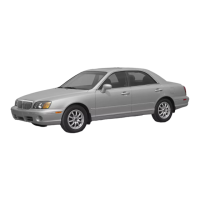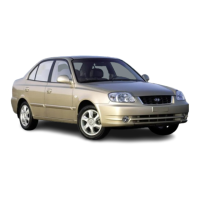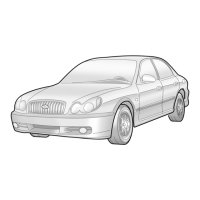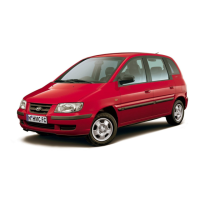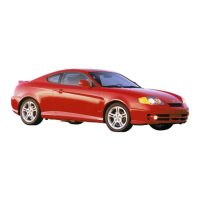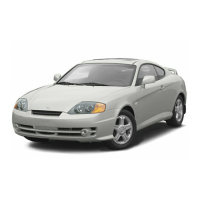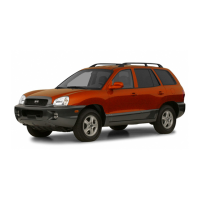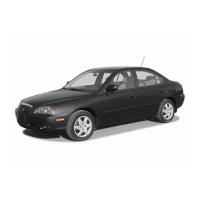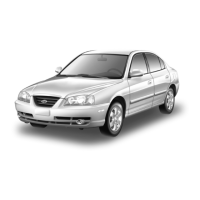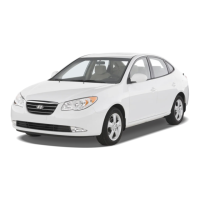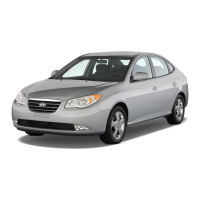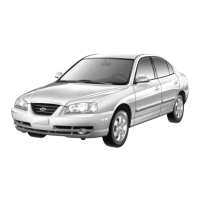Do you have a question about the Hyundai 2003 Elantra and is the answer not in the manual?
Details on limited warranties for your Hyundai vehicle, including powertrain and anti-perforation.
Owner's responsibility to ensure all maintenance operations are carried out at appropriate intervals.
Explanation of Hyundai Genuine Parts used in vehicle manufacturing, designed for safety and reliability.
Benefits of using genuine Hyundai parts and consequences of using imitation parts.
How to identify genuine Hyundai parts by looking for the logo and checking packaging labels.
Guidance on using unleaded gasoline, gasohol, MTBE, and avoiding methanol for optimal engine performance.
Recommendations for the first 1,200 miles (2,000 km) to ensure economical operation and durability.
Information on using keys, recording key numbers, and obtaining replacement keys from a dealer.
Safety warning about locking doors and instructions for locking/unlocking front doors with a key.
Explanation of the child-protector feature for rear doors to prevent opening from the inside.
How to operate the central door locking system using the driver's door switch or key.
Details on operating the theft-alarm system, including armed, alarm, and disarmed stages.
Instructions on operating power windows, including warnings about trapping body parts.
Guidance on adjusting front seats, including warnings against adjusting while driving.
Mandatory seat belt usage for all occupants, including warnings about airbags and child restraints.
Information on child restraint laws, proper installation, and safety standards for child safety seats.
Explanation of the pre-tensioner seat belt system and its function in frontal collisions.
Overview of the SRS system, its components, and how airbags deploy with seat belts in frontal impacts.
Details on side impact airbags, their purpose, and deployment conditions in side collisions.
Overview of the vehicle's instrument panel, gauges, and interior controls.
Identification and explanation of various indicators and gauges on the instrument cluster.
Explanation of various warning lights and chimes, including SRS, ABS, oil pressure, and seat belt warnings.
How to read the engine coolant temperature gauge and actions to take if overheating occurs.
Information on the speedometer calibration in miles per hour and kilometers per hour.
Explanation of the tachometer's function in measuring engine speed (rpm) for optimal shifting.
How to read the odometer and trip odometer, including function of digital displays and reset switch.
Explanation of the trip computer's functions, including tripmeter, fuel consumption, and distance to empty.
Operation of the multi-function switch for turn signals, headlights, and high beams.
Instructions for operating the windshield wipers and washer system, including intermittent and low-speed modes.
How to operate the rear window defroster, including automatic shut-off and cleaning precautions.
Guidance on using the hazard warning system for emergencies, causing all turn signals to blink.
Instructions for operating the sunroof, including opening, closing, tilting, and sunshade.
Details on adjusting manual and electric outside rearview mirrors for optimal rear vision.
Instructions on engaging and releasing the parking brake, and its indicator light operation.
Procedure for opening the hood, securing the support rod, and closing the hood safely.
How to open the fuel-filler lid using the remote release lever and precautions for refueling.
Instructions on setting, canceling, and resuming cruise control speed, with safety warnings.
Explanation of heating and ventilation controls, including air flow, intake, temperature, and fan speed.
How to operate the air conditioning system, including cooling, dehumidified heating, and operation tips.
Basic principles of AM/FM radio reception and how car audio systems reproduce sound.
Detailed instructions for operating the stereo radio, including tuning, presets, band selection, and controls.
Instructions for operating the cassette tape player, including FF/REW, AUTO MUSIC SELECT, and DOLBY SELECT.
How to operate the CD player, including track selection, scanning, repeat, and eject functions.
Instructions for using the CD auto changer, including disc selection, track control, and scan functions.
Troubleshooting guide for audio system error indications, listing causes and solutions for common fault codes.
Proper handling, cleaning, storage, and identification of damaged discs for optimal playback.
Information on the fixed rod antenna and glass antenna, including removal, installation, and cleaning precautions.
Critical warnings about the dangers of engine exhaust fumes and safe practices.
Pre-start checks including tires, brakes, windows, mirrors, seats, doors, seat belts, and lights.
Explanation of ignition key positions (LOCK, ACC, ON, START) and their functions.
Step-by-step procedure for starting the engine, including normal conditions and safety precautions.
Instructions for operating the manual transaxle, including shift patterns, clutch use, and recommended shift points.
Explanation of automatic transaxle functions, including gear positions (P, R, N, D, 3, 2, L) and cautions.
How ABS prevents wheel lock-up during braking and its effect on braking distance.
Function of TCS in limiting wheel spin on slippery surfaces for better acceleration and control.
Tips for saving fuel and improving mileage, including smooth driving and moderate speed.
Essential guidelines and precautions for towing trailers or vehicles, including hitch selection and safety chains.
Troubleshooting steps if the engine fails to start, including warnings against push-starting.
Procedure for handling engine stalls while driving, including safe stopping and attempting to restart.
Detailed instructions and safety precautions for jump starting a vehicle with a discharged battery.
Steps to take if the engine overheats, including pulling over, turning off the engine, and checking coolant.
Instructions for handling the spare tire, checking pressure, and changing a flat tire.
Guidelines for towing your car, including proper methods and precautions to avoid damage.
Information on obtaining replacement keys and opening doors if keys are locked inside.
How Hyundai's design and owner cooperation ensure long-term corrosion resistance.
Identification of common causes of car corrosion, such as road salt, dirt, moisture, and minor damage.
Observing key practices like keeping the car clean, especially the underside, and washing regularly.
Proper techniques for washing and waxing your car, including shade washing and using appropriate cleaners.
Methods for cleaning interior surfaces like vinyl upholstery, carpets, and seat belts.
Using household cleaners for windows, with caution for the rear window defroster wiring.
Ensuring maximum vehicle life and satisfaction through required maintenance procedures.
Services required for good emission control and performance, with mileage and time intervals.
Identifying items needing more frequent servicing for cars used under severe driving conditions.
Detailed explanations for various maintenance items like engine oil, fuel filter, drive belts, and spark plugs.
Diagram and identification of components in the 2.0 DOHC engine compartment.
Diagram and identification of components in the 2.0 SULEV engine compartment.
Regular checks for engine compartment, vehicle exterior, and interior operations.
Importance of checking engine oil level and condition regularly, with recommended oil types.
Step-by-step procedure for changing engine oil and filter, including safety and disposal instructions.
Procedure for checking coolant level and changing engine coolant, with safety warnings.
When to change spark plugs, symptoms of poor performance, and recommended spark plug types.
Step-by-step guide for changing spark plugs, including safety precautions and tightening torque.
Instructions for replacing the air cleaner filter, emphasizing the use of genuine Hyundai parts.
Procedure for checking manual transaxle oil level, recommended oil, and capacity.
How to check automatic transaxle fluid level, recommended fluid, and capacity.
Importance of checking brakes and fluid levels, with dealer inspection recommendations.
Procedure for checking brake fluid level in the reservoir and adding fluid if necessary.
How to check clutch fluid level, potential leaks, and recommendations for replacement fluid.
How to check steering wheel free-play and when to have it inspected or adjusted by a dealer.
Procedure for checking drive belts for tension, wear, and routing, and when to replace them.
How to identify and replace blown fuses and fusible links, with safety precautions.
Precautions and procedures for checking the battery, including safety warnings about acid and gases.
Information on the operation of engine cooling fans and condenser cooling fans.
Step-by-step instructions for replacing headlight bulbs, including safety and aiming.
Procedure for adjusting headlight aim using an aiming screen, including specifications for alignment.
Explanation of the Positive Crankcase Ventilation System for preventing air pollution from blow-by gases.
How the system prevents fuel vapors from escaping into the atmosphere, including canister and PCSV.
Description of the exhaust emission control system for managing exhaust emissions and maintaining performance.
Information on the catalytic converter's role in reducing pollutants and risks associated with overheating.
Locations where the Vehicle Identification Number (VIN) can be found on the car.
Recommended tire inflation pressures for optimal ride comfort, tire wear, and stability.
Explanation of uniform tire quality grading, including treadwear, traction, and temperature ratings.
Guidelines for equipping the car with snow tires, including size, load capacity, and pressure.
Information on installing tire chains on front wheels, proper size, and minimizing wear.
Recommendation to rotate tires every 7,500 miles (12,000 km) and check for uneven wear.
Factors affecting tire traction, such as worn tires, improper inflation, and slippery surfaces.
Identifying when tires need replacement based on tread wear indicators and warnings about mixing tire types.
List of items included with the vehicle for spare tire and wheel replacement.
Information on obtaining the Hyundai Shop Manual for detailed technical guidance.
Summary of Hyundai's limited warranties, including new vehicle, powertrain, and emissions warranties.
How to report vehicle defects to NHTSA and Hyundai Motor America for safety investigations.
Key vehicle dimensions including overall length, width, height, wheelbase, and wheel tread.
Details on standard and spare tire sizes and recommended tire pressures.
Specifications for the power steering system, including type, free play, rack stroke, and oil pump type.
Details on the vehicle's battery and alternator specifications.
Information on the brake system type, front/rear brake types, and parking brake mechanism.
Fuel tank capacity in US gallons, Imperial gallons, and liters.
Detailed engine specifications for 2.0 L and 2.0 L SULEV models, including type, idle speed, and spark plugs.
Recommended oil and grease standards, quantities, and service intervals for various vehicle components.
| Brand | Hyundai |
|---|---|
| Model | 2003 Elantra |
| Category | Automobile |
| Language | English |
